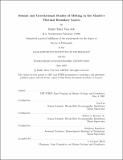| dc.contributor.advisor | Jian Lin, Robert S. Detrick, Jr., and Stéphane Rondenay. | en_US |
| dc.contributor.author | Van Ark, Emily M | en_US |
| dc.contributor.other | Woods Hole Oceanographic Institution. | en_US |
| dc.date.accessioned | 2008-03-26T21:09:50Z | |
| dc.date.available | 2008-03-26T21:09:50Z | |
| dc.date.copyright | 2007 | en_US |
| dc.date.issued | 2007 | en_US |
| dc.identifier.uri | http://hdl.handle.net/1721.1/40865 | |
| dc.description | Thesis (Ph. D.)--Joint Program in Marine Geology and Geophysics (Massachusetts Institute of Technology, Dept. of Earth, Atmospheric, and Planetary Sciences; and the Woods Hole Oceanographic Institution), 2007. | en_US |
| dc.description | This electronic version was submitted by the student author. The certified thesis is available in the Institute Archives and Special Collections. | en_US |
| dc.description | Includes bibliographical references (p. 167-196). | en_US |
| dc.description.abstract | This thesis presents three studies which apply geophysical tools to the task of better understanding mantle melting phenomena at the upper and lower boundaries of the mantle. The first study uses seafloor bathymetry and small variations in the gravitational acceleration over the Hawaii-Emperor seamount chain to constrain the changes in the igneous production of the hot spot melting in the mantle which has created these structures over the past 80 My. The second study uses multichannel seismic reflection data to constrain the location and depth of axial magma chambers at the Endeavour Segment of the Juan de Fuca spreading ridge, and then correlates these magma chamber locations with features of the hydrothermal heat extraction system in the upper crust such as microseismicity caused by thermal cracking and high temperature hydrothermal vent systems observed on the seafloor. The third study uses two-dimensional global pseudospectral seismic wave propagation modeling to characterize the sensitivity of the SPdKS seismic phase to two-dimensional, finite-width ultra-low velocity zones (ULVZs) at the core-mantle boundary. Together these three studies highlight the dynamic complexities of melting in the mantle while offering new tools to understand that complexity. | en_US |
| dc.description.statementofresponsibility | by Emily Mary Van Ark. | en_US |
| dc.format.extent | 196 | en_US |
| dc.language.iso | eng | en_US |
| dc.publisher | Massachusetts Institute of Technology | en_US |
| dc.rights | M.I.T. theses are protected by
copyright. They may be viewed from this source for any purpose, but
reproduction or distribution in any format is prohibited without written
permission. See provided URL for inquiries about permission. | en_US |
| dc.rights.uri | http://dspace.mit.edu/handle/1721.1/7582 | en_US |
| dc.subject | Earth, Atmospheric, and Planetary Sciences. | en_US |
| dc.subject | Joint Program in Marine Geology and Geophysics. | en_US |
| dc.subject | Woods Hole Oceanographic Institution. | en_US |
| dc.subject.lcsh | Ocean bottom | en_US |
| dc.subject.lcsh | Core-mantle boundary | en_US |
| dc.title | Seismic and gravitational studies of melting in the mantle's thermal boundary layers | en_US |
| dc.type | Thesis | en_US |
| dc.description.degree | Ph.D. | en_US |
| dc.contributor.department | Joint Program in Marine Geology and Geophysics | en_US |
| dc.contributor.department | Woods Hole Oceanographic Institution | en_US |
| dc.contributor.department | Massachusetts Institute of Technology. Department of Earth, Atmospheric, and Planetary Sciences | |
| dc.identifier.oclc | 213099007 | en_US |
